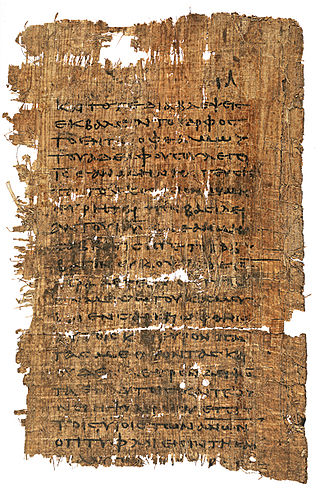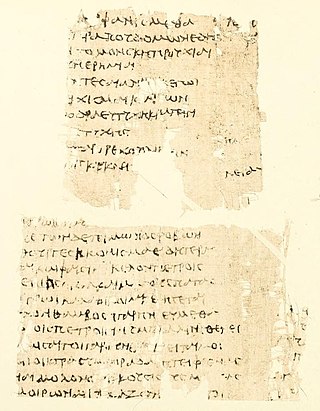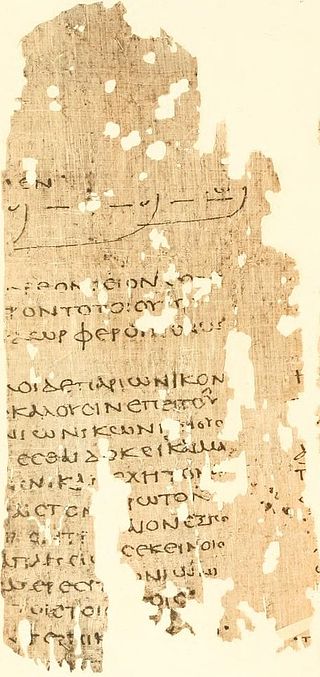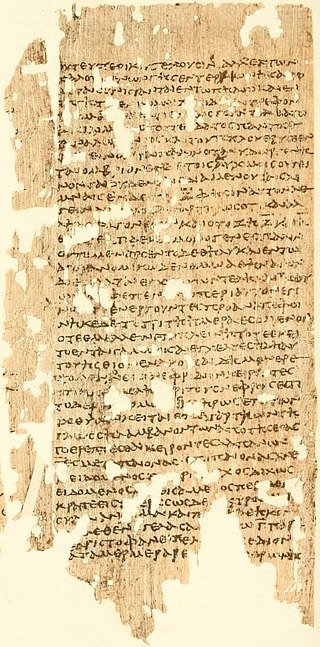Related Research Articles

Papyrus Oxyrhynchus 1 is a papyrus fragment of the logia of Jesus written in Greek. It was among the first of the Oxyrhynchus Papyri discovered by Grenfell and Hunt. It was discovered on the second day of excavation, 12 January 1897, in the garbage mounds in the Egyptian town of Oxyrhynchus. The fragment is dated to the early half of the 3rd century. Grenfell and Hunt originally dated the fragment between 150 and 300, but "probably not written much later than the year 200." It was later discovered to be the oldest manuscript of the Gospel of Thomas.
Papyrus Oxyrhynchus 4 is a fragment of a Christian theological work in Greek. It was discovered by Grenfell and Hunt in 1897 in Oxyrhynchus. The fragment is dated to the early 4th century. It is housed in the library of the University of Cambridge. The text was published by Grenfell and Hunt in 1898.
Papyrus Oxyrhynchus 5 is a fragment of a Christian homily, written in Greek. It was discovered by Grenfell and Hunt in 1897 in Oxyrhynchus. The fragment is dated to the late third or early fourth century. It is housed in the Bodleian Library. The text was published by Grenfell and Hunt in 1898.

Papyrus Oxyrhynchus 7 is a papyrus found at Oxyrhynchus in Egypt. It was discovered by Bernard Pyne Grenfell and Arthur Surridge Hunt in 1897, and published in 1898. It dates to the third century AD. The papyrus is now in the British Library.

Papyrus Oxyrhynchus 16 is a fragment of the fourth book of the History of the Peloponnesian War by Thucydides in Greek. It was discovered by Grenfell and Hunt in 1897 in Oxyrhynchus. The fragment is dated to the first century. It is housed in the University of Pennsylvania Museum. The text was published by Grenfell and Hunt in 1898.
Papyrus Oxyrhynchus 43 is a fragment with the texts of two documents by unknown authors, written in Greek. It was discovered by Grenfell and Hunt in 1897 in Oxyrhynchus. It is housed in the British Museum (748) in London. The text was published by Grenfell and Hunt in 1898.
Papyrus Oxyrhynchus 62 is a letter from a centurion, written in Greek. The manuscript was written on papyrus in the form of a sheet. It was discovered by Grenfell and Hunt in 1897 in Oxyrhynchus. The document was written on 6 January 222. Currently it is housed in the Bodleian Library in Oxford. The text was published by Grenfell and Hunt in 1898.
Papyrus Oxyrhynchus 85 is part of a series of declarations by various guilds of workmen, written in Greek. The manuscript was written on papyrus in the form of a sheet. It was discovered in Oxyrhynchus. The document was written on 26 November 338. Currently it is housed in the Department of Manuscripts of the British Museum (760) in London.
Papyrus Oxyrhynchus 654 is a papyrus fragment of the logia of Jesus written in Greek. It is one of the Oxyrhynchus Papyri discovered by Grenfell and Hunt between 1897 and 1904 in the Egyptian town of Oxyrhynchus. The fragment is dated to the middle or late of the 3rd century. It is one of only three Greek manuscripts of the Gospel of Thomas.

Papyrus Oxyrhynchus 655 is a papyrus fragment of the logia of Jesus written in Greek. It is one of the Oxyrhynchus Papyri discovered by Grenfell and Hunt between 1897 and 1904 in the Egyptian town of Oxyrhynchus. The fragment is dated to the early 3rd century. It is one of only three Greek manuscripts of the Gospel of Thomas.
Papyrus Oxyrhynchus 92 is an order for payment, written in Greek. The manuscript was written on papyrus in the form of a sheet. It was discovered in Oxyrhynchus. The document was written on 15 October 336. Currently it is housed in the Houghton Library of Harvard University in Cambridge.
Papyrus Oxyrhynchus 118 is a personal letter, written in Greek and discovered in Oxyrhynchus. The manuscript was written on papyrus in the form of a sheet. The document was written in the late 3rd century. Currently it is housed in the Cambridge University Library (4043) at Cambridge University.
Papyrus Oxyrhynchus 124 is a student's composition, written in Greek and discovered in Oxyrhynchus. The manuscript was written on papyrus in the form of a sheet. The document was written in the 3rd century. Currently it is housed in the library of Winchester College in Winchester.
Papyrus Oxyrhynchus 127 is an account of contributions of wheat sent annually to Alexandria and Constantinople, written in Greek and discovered in Oxyrhynchus. The manuscript was written on papyrus in the form of a sheet. The document was written in the late 6th century. Currently it is housed in the Egyptian Museum (10084) in Cairo.

Papyrus Oxyrhynchus 213 consists of two fragments of a tragedy by an unknown author, written in Greek. It was discovered in Oxyrhynchus. The manuscript was written on papyrus in the form of a roll. It is dated to the second century. Currently it is housed in the British Library in London.

Papyrus Oxyrhynchus 220 is a treatise on prosody, written by an unknown author in Greek. It was discovered in Oxyrhynchus. The manuscript was written on papyrus in the form of a roll. It is dated to the first century or second century AD. Currently it is housed in the British Library in London.

Papyrus Oxyrhynchus 221 contains Homeric scholia by an unknown author, written in Greek. It was discovered in Oxyrhynchus, Egypt. The manuscript was written on papyrus in the form of a roll. It is dated to the second century. Frederic G. Kenyon dated it to the first century or the first half of the second century. Currently it is housed in the British Library in London.
Papyrus Oxyrhynchus 223 is a fragment of Homer's Iliad (E,329-705), written in Greek. It was discovered in Oxyrhynchus. The manuscript was written on papyrus in the form of a roll. It is dated to the third century. Currently it is housed in the Bodleian Library in Oxford.
Papyrus Oxyrhynchus 232 is a fragment of Contra Timocratem by Demosthenes, written in Greek. It was discovered in Oxyrhynchus. The manuscript was written on papyrus in the form of a roll. It is dated to the second or third century. Currently it is housed in the British Library in London.
Papyrus Oxyrhynchus 237 consists of a fragment of Petition of Dionysia to the Praefect, written in Greek. They were discovered in Oxyrhynchus. The manuscript was written on papyrus in the form of a roll. It was written after 27 June 186. Currently it is housed in the Bodleian Library.
References
- 1 2 3 D'Alessio, Giovan Battista (2001). "Danni materiali e ricostruzione di rotoli papiracei: Le Elleniche di Ossirinco ("POxy" 842) e altri esempi". Zeitschrift für Papyrologie und Epigraphik (in Italian). 134: 26.
- ↑ Lehmann, G. A. (1977). "Ein neues Fragment der Hell. Oxy.: Einige Bemerkungen zu P. Cairo (Temp. inv. no.) 26/6/27/1-35". Zeitschrift für Papyrologie und Epigraphik (in German). 26: 181.
- 1 2 3 4 Grenfell & Hunt, The Oxyrhynchus Papyri: Part V (1908), p. 110
- ↑ Del Corso, Lucio (2006). "Lo 'stile severo' nei P.Oxy.: una lista". Aegyptus (in Italian). 86: 84.
- ↑ Orisini, P.; Clarysse, Willy (2012). "Early New Testament Manuscripts and their Dates: A Critique of Theological Palaeography". Ephemerides Theologicae Lovanienses. 88 (4): 456.
- ↑ LDAB 583